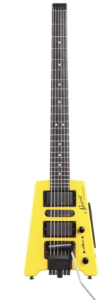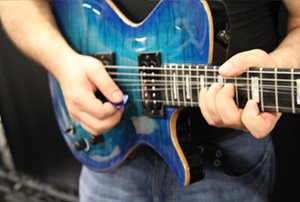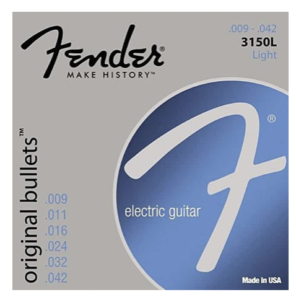 Buying a new guitar is great experience for music lovers. But it is important to have some basic knowledge of the instrument. In this article you’ll learn about the parts of a guitar.
Buying a new guitar is great experience for music lovers. But it is important to have some basic knowledge of the instrument. In this article you’ll learn about the parts of a guitar.
If its your first time buying a guitar, I think it is useful to know well the different parts of a guitar before buying your new instrument.
In this article I’ll give a quick description of the main parts of the guitar.
For more in depth information about similar guitar topics, I have a free 60 page PDF course that you can get by email.
Guitar Neck
 The headstock is where you’ll find the tuning heads and the gears used to tune the guitar. Take a look at these parts of the instrument to make sure that they’re made of a quality material.
The headstock is where you’ll find the tuning heads and the gears used to tune the guitar. Take a look at these parts of the instrument to make sure that they’re made of a quality material.
You should also check if the tuning heads are easy to use and are not too hard to move.
The tuning heads are usually turned by hand, which then moves the tuning posts. This will then make the strings tighter or looser, thus changing their tune.
Also, check how to use guitar neck shims.
Guitar Body
The body of the guitar is the part that contains the sounding hole, if it is an acoustic guitar. This place is occupied by the pickups for electric instruments.
For an acoustic guitar, the main consideration is the quality of the wood used for the guitar body construction. A good instrument will have high quality woods that will produce a better and louder sound.
 For electric guitars, the wood quality is less important than the pickups used in the instrument. In an electric guitar, the sound is generated directly from the strings to the pickups. This means that the body wood is less important.
For electric guitars, the wood quality is less important than the pickups used in the instrument. In an electric guitar, the sound is generated directly from the strings to the pickups. This means that the body wood is less important.
The instrument body still has some important parts like the bridge. The bridge is the place where the strings are placed, and it can be used to adjust the intonation, the height and the action of the strings. Therefore, a good quality bridge, made of resistant material is a necessity.
The bridge is frequently made of metal, but acoustic instruments may also use wood or plastic.
Also Read:
Starfire: Semi-Hollow Electric Guitar
GTRS S800: The Intelligent Guitar With FX Effects
Yamaha CG-TA: TransAcoustic Classical Guitar
10 Best Online Guitar Courses for Beginners
Electric Parts on Guitar Fetish
7 Products To Maintain and Clean Your Guitar
Other Important Parts
 Headstock: the headstock is the part of the guitar where you’ll find the tuning pegs, and the mechanism that attaches to the strings. A headstock is a very distinctive part of the guitar.
Headstock: the headstock is the part of the guitar where you’ll find the tuning pegs, and the mechanism that attaches to the strings. A headstock is a very distinctive part of the guitar.
Tuning Pegs: the tuning pegs are used to keep the strings in tune. The whole tuning mechanism is connected to the pegs, so you can easy increase or reduce the tensions in the strings.
Capstan/string post: the string post, also known as capstan, is the post made of metal or wood, used to hold the strings.
Nut: the nut is the part where the sounding part of the string is fixed. The nut is responsible for the quality of the sound in a guitar. Therefore, the nut must be made of resistant and good quality materials. The nut may need replacement after a few years of use.
First String: the strings are numbered from top to bottom. The first string is the bottom string, usually turned to an E.
Fingerboard: the fingerboard is the wood part where the frets are located. It is important to have a high quality fingerboard, because this will allow you to move freely over the board. You usually need very strong and durable wood types to create a good fingerboard.
Position markers: these are markets that are used to indicate the position over the fingerboard. Just like the piano has distinctive patterns in the keyboard, the guitar also usually has position markers in the fingerboard.
Upper bout
Sound hole
Rosette
Pick guard
Waist
Saddle
Bridge
Bridge Pins
Body
Lower Bout
Strap Peg
output jack
Volume control
Tone control
Whammy bar
pickups
The Strings
The strings are also an important parts. They define a lot of the sound quality for a particular instrument.
However, because strings can be easily replaced and are very cheap, you don’t need to worry too much about the strings in an instrument. You can always change to something that you like better.
There are two main types of strings used in guitars: nylon and metal (usually steel). Nylon strings are used mainly in standard or classical guitars. They produce a mellow sound, and are perfect for classical pieces that require a sweet and warm tone.
The other type of common strings are made of metal. The main characteristic of these strings is that they produce a very bright sound, and also higher volume compared to nylon strings. They are preferred for more popular styles like blues and rock, where they’re used to project higher sound in accompaniment and in quick solos.
Metal strings are also essencial for electric guitars, because the pickup is based on electro magnetic signals which work only on metal strings.
One of the important characteristics of strings is the distance to the fretboard. This is called the action. If the distance is to high, this makes it difficult to press the strings for chords and notes, specially at higher positions. If the action is too low, though, you can feel undesired string buzz, specially for novice players.
Get More Information
For more in depth description about the guitar, I have a free 60 page PDF course by email, which explains how to buy, maintain, and play a guitar.
Discover more from Play Guitar Review
Subscribe to get the latest posts sent to your email.

